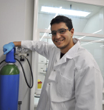Cooperative metal centers for the activation of oxygen and related small molecules
 |
Name: |
Simone Bertini |
 |
| eMail: |
simone.bertini@dcb.unibe.ch |
| Institution: |
University of Bern (UBERN) |
| Start Date: |
1/6/2016 |
Return |
| Supervisors: |
Prof dr. Martin Albrecht |
|
| |
|
|
| |
|
|
|
Activation of dioxygen supposedly proceeds via a high-valent metal center. Access of high oxidation states and hence stabilization of the critical intermediates is promoted by strong donor ligands such as (mesoionic) N-heterocylic carbenes due to their flexible donor properties and their responsiveness to the electronic configuration at the metal center. In addition, the cooperative interaction of two metal centers in different coordination environments is expected to further facilitate bond breaking, since perturbation of the strong O=O bond (and similarly the strong C–O bonds in CO and CO2 , and the C-C bond) leads to significant polarization, which is enhanced by the presence of two metal centers with different electron density and different bonding preferences. Therefore, the principal aim of the proposed research is the bonding and activation of small molecules in mild conditions by using new first row dimetallic complexes. These metals are particularly suitable for this work since they have a rich redox chemistry with high and low valent centers accessible, and they effectuate such bond activation also in natural systems (cf. Fe in cytochrome P450). These bimetallic systems will be available from ditopic ligand precursors that contain carbene bonding sites and N or O bonding sites for embedding an electron-rich and a relatively electron-poor metal center, respectively.
